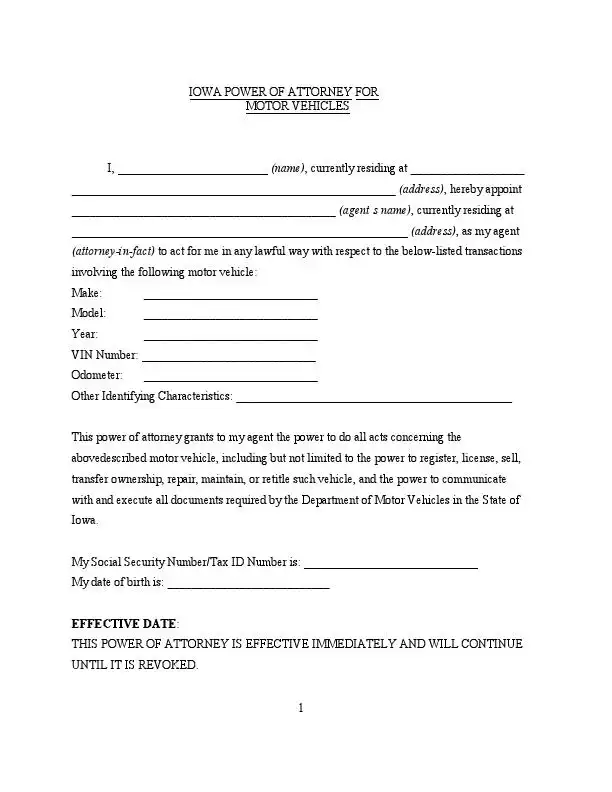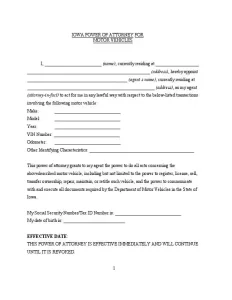Iowa Motor Vehicle Power of Attorney Form
The Iowa motor vehicle power of attorney is a legal document that authorizes an individual, known as the agent, to make decisions and take actions regarding another person’s vehicle, including but not limited to registration, title transfer, and dealings with the Iowa Department of Transportation.

Build Your Document
Answer a few simple questions to make your document in minutes
Save and Print
Save progress and finish on any device, download and print anytime
Sign and Use
Your valid, lawyer-approved document is ready
To complete the power of attorney template, the vehicle owner (principal) must provide detailed information, including the full name, address, and vehicle description (make, model, VIN, etc.). This form must also indicate the specific transactions the appointed agent is authorized to handle.
The form and its execution are governed by § 400.14(6) of the Iowa Code, which provides the general framework for powers of attorney related to motor vehicles. As per § 633B.105, the principal’s signature (the vehicle owner granting the power) must be notarized. This means the principal must sign the form in the presence of a notary public who certifies the document. This ensures the legality and validity of Iowa POA forms when presented to the Iowa Department of Transportation or any other relevant entity.
Iowa Motor Vehicle Power of Attorney Form Details
| Document Name | Iowa Motor Vehicle Power of Attorney Form |
| State Form Name | Form 411021 |
| Relevant Link | Iowa Department of Transportation |
| Avg. Time to Fill Out | 15 minutes |
| # of Fillable Fields | 28 |
| Available Formats | Adobe PDF |
Filling Out Iowa Vehicle POA
Filling out the Iowa motor vehicle power of attorney (Form 411021) requires careful attention to detail to ensure that all parts are completed accurately. This form grants authority to another person (agent) to handle certain vehicle-related matters on behalf of the principal (vehicle owner).
1. Begin with Your Personal Information
Start by entering your full legal name as the principal and address, including county and state. This information helps establish your identity and residency, which are critical for the validity of the power of attorney.
2. Detail the Agent’s Information
Specify the name and full address of the person you are appointing as your agent. This individual will be authorized to act on your behalf in vehicle-related transactions, so their information must be recorded precisely.
3. Define the Scope of Authority
You need to clarify what your agent is allowed to do. This includes actions like applying for a certificate of title, assigning title, handling replacement titles, and dealing with security interests on the vehicle. Indicate each specific action your agent can perform by checking the appropriate boxes on the form.
4. Vehicle Information Section
Provide detailed information about the vehicle involved. This section should include the make, model, style, year, color, and vehicle identification number (VIN). Accurate vehicle details are crucial for any transactions the agent will handle.
5. Sign and Date the Form
You, the principal, must sign the form in the presence of a notary public. The date of signing should also be recorded accurately. Ensure the signature takes place under the observation of the notary to fulfill the legal requirements for notarization.
6. Notarization
The notary public will verify your identity and witness your signature before notarizing the form. This step is essential as it validates the authenticity of the power of attorney.
